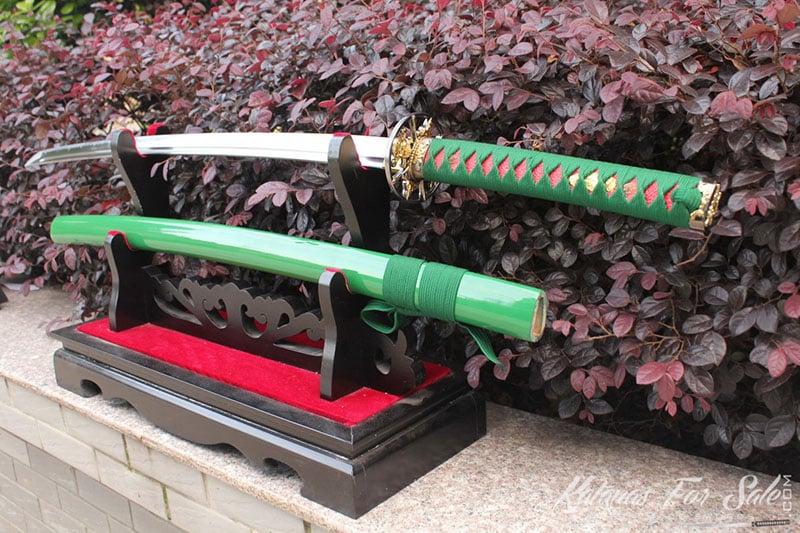
A persons height did occur to me as well because it seemed small for someone of my height(6'3). It is the only true original Daisho that i have ever found so i also thought it was quite rare. As the result, in the beginning of Edo period (early 1600s), there were still some chonin (i.e., townsmen) class commoners and many yakuza gangs who openly carried long wakizashi (i.e., called "oo-wakizashi") that were virtually equivalent in length to prohibited katana (Iiyama, 1995 Kokubo, 1993).Ĥ.Katate-uchigatana not only had the short nakago but also had shorter handles, any sword though can be used for a katate-uchi This was partially because many of those older laws had varying definitions of katana, wakizashi and tanto in terms of their lengths. However, until many years after the end of the Japanese Civil War (circa 1600) those old laws regulating the bearers of swords were not always followed by the people in Japan. Therefore, it was during the late Momoyama period when the specific ranges of blade lengths started becoming the official (=legal) criteria to designate different types of swords into specific categories such as katana, wakizashi, tanto, etc. Since after the end of Muromachi period, the rulers of Japan (e.g., Hideyoshi Toyotomi, Iyeyasu Tokugawa) began issuing a number of executive orders to regulate who were allowed to wear what type swords based mostly on ones ascription all in order to protect the power, status and prestige of the samurai class. Again, up until later periods, there had been no legally specified lengths for tachi, katana, wakizashi and tanto in Japan. It was during Tenbun through Eiroku eras (circa 1532 through 1569) that wearing dai-sho pair of uchigatana - that is katana and wakizashi - became a common practice amongst the samurai class. Tachi 太刀 of more than 3 Shaku (90.9 cm) are referred to as Ōdachi 大太刀, whereas Tachi under 2 Shaku 尺 (60.6 cm) are called Kodachi 小太刀. There was no standard length for Wakizashi, but those over 1 Shaku 尺 8 Sun 寸, or 54.5 cm, are called Ō-Wakizashi 大脇指. Tantō longer than Teisun are called Sunnobi-Tantō 寸延び短刀, and less than Teisun Sunzumari-Tantō 寸詰まり短刀. The “standard / average” length during the Edo period was called Teisun 定寸 it’s 2 Shaku 尺 3 Sun 寸 5 Bu 分 (71.2 cm) for Katana, and 8 Sun 寸 5 Bu 分 (25.8 cm) for Tantō. The Kanejaku – or Shaku for short – was/is the unit used for sword lengths, and the various government restrictions on sword lengths of the Edo period are based on it. There also was a Shaku written with a different Kanji - 勺 – used for land pricing and Saké units. There are two types of Shaku 尺: the “standard” Kanejaku 曲尺 (10/33 meters = 11.93 inches), and the Kujirajaku 鯨尺 (25/66 meters = 14.9 inches) used only for measuring clothes. In 1891 the government merely defined the metric equivalences in 1924 it was replaced by the metric system. The Shakkanhō 尺貫法 (traditional Chinese measurement system ) was already “standardized” early on, and firmly in place during the Edo period. PS it looks like your set is original and that sir is pretty rare, size not being everything So while your blade may have been a katate-uchigatana when made the longer handle suggests two handed use as you point out.Ĥ.Katate-uchigatana not only had the short nakago but also had shorter handles, any sword though can be used for a katate-uchi strike.Īlso I hope someone will tell the SFI folks that "Katte-uchi" sounds like mumbling and not a contraction of Katate - not a commonly used one anyway. Length is not the only criteria though.ģ.Dai-sho are more an Edo period thing. Therefore you need to learn to recognize length and blade geometry as indicators of how it might have been used if there is only shirasaya. You can see yari mounted as katana and other examples of things like this. A tanto could be put into wakizashi mounts then it would be a wakizashi until you were looking at the blade alone.

a mumei blade say 26-28 inches and not of great age would be called a katana for lack of other evidence. Thus shorter katana like yours are not so uncommon.Ģ.the koshirae often makes the sword a mumei blade in original tachi mounts would be referred to as a tachi. Though we cannot see the kojiri on the longer of the two swords it seems pretty obvious that this is the Dai for your Dai-sho and is a Katana, whatever the length.ġ.most folks were not that tall and their hands were only so big.


 0 kommentar(er)
0 kommentar(er)
